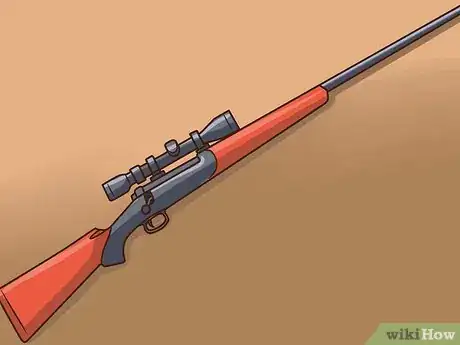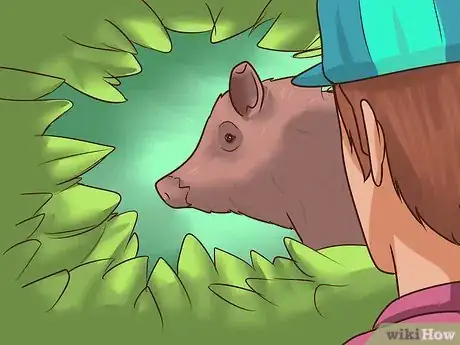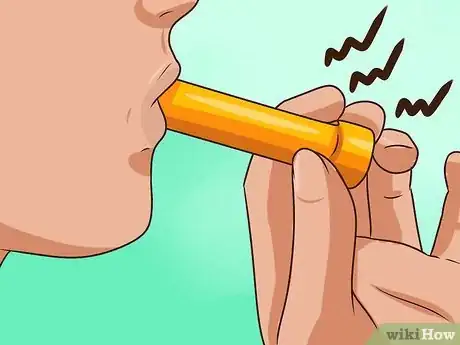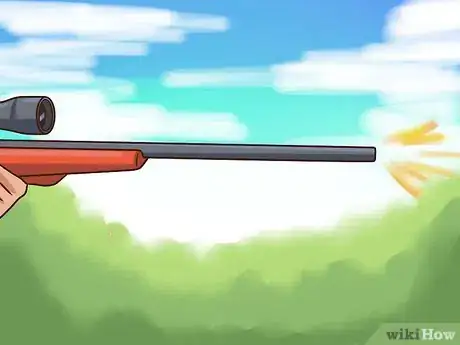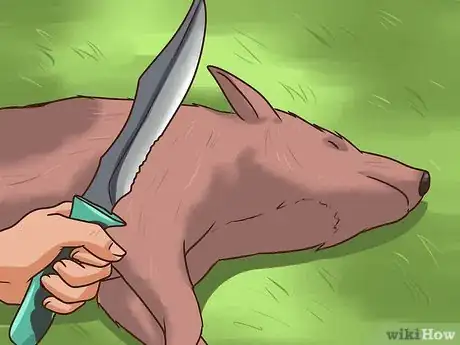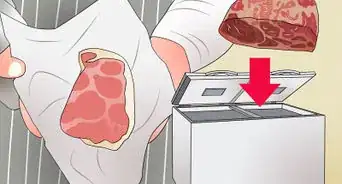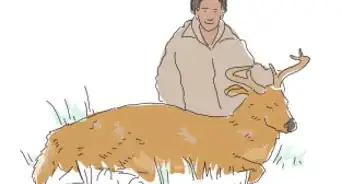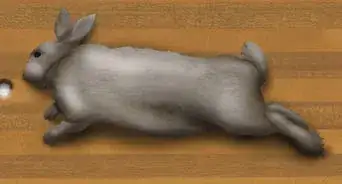wikiHow is a “wiki,” similar to Wikipedia, which means that many of our articles are co-written by multiple authors. To create this article, 14 people, some anonymous, worked to edit and improve it over time.
There are 11 references cited in this article, which can be found at the bottom of the page.
This article has been viewed 43,940 times.
Learn more...
Feral hogs were introduced to North America by Spanish explorers in the 1500s. Since that time, they have spread across the land, creating a nuisance for farmers and damaging the environment. Because of this, most states allow virtually unlimited hunting of these animals. Hog hunting can be fun, can provide tasty meat, and can help to limit the expansion of these destructive and prolific beasts. Follow these steps to get started on your first hog hunting adventure.
Steps
Getting Ready
-
1Learn the regulations. Because feral hogs are a non-native species that compete for food with wildlife and livestock and destroys the habitat of native species, most states with a wild hog population have very relaxed regulations for hunting them. Even so, it's important to know the law in your state.
- In Texas, for example, hogs can be hunted every day of the year and any time of the day. Under some specific circumstances, you don't even need a license.
- By contrast, in Oklahoma, hogs can only be hunted in the daytime, and on public lands may only be hunted during certain times of the year.[1]
-
2Find a place to hunt. Many property owners will allow you to hunt hogs on their land, either for free as a means of eliminating unwanted hogs, or for a fee.
- Check the internet and newspaper classifieds to find a place near you to hunt hogs.
- Currently, feral hogs are most plentiful in the south, but can be found in 35 states. Because they are so prolific, many believe it's only a matter of time until they are in all of the lower 48.
Advertisement -
3Choose a firearm. When selecting a firearm to hunt hogs, the most important thing to consider is accuracy. Hogs are tough animals, so if you don't hit a vital organ, they are likely to flee.[2]
- Also important is the caliber of the weapon. Because hogs are tough, guns that fire larger rounds are usually a superior choice.
- The minimum caliber for a hog hunting rifle is the .270 Winchester. A better choice is a .30 caliber rifle such as the .308 or the .300 Winchester Magnum.[3]
- Other good options include the Browning Automatic Rifle, which comes in a special Hog Stalker model just for hog hunters.[4] Other firearm manufactures also offer specialty hog hunting weapons such as the Savage Hog Hunter and the Weatherby Hog Reaper.[5]
- You may also wish to consider a silencer, as this will make it harder for hogs to locate you after you've fired, and will also dampen the muzzle flash if you are hunting at night.
-
4Scout the land. Once you've found a place to hunt hogs, it's a good idea to scout out the land in advance to find the best places on the property to stalk hogs or set up a stand.
- Look for hog droppings or signs that hogs have been rooting (digging) in the area. Land that hogs have rooted on generally looks as though it has been plowed.[6]
- Hogs like to wallow in mud and shallow ponds, making such areas ideal places to hunt.
- Placing motion-activated game cameras around the property is another good way to figure out where hogs gather.[7]
Hunting Hogs
-
1Hunt from a stand. Especially if the weather is bad, you might want to hunt hogs from a stand or blind. This is basically a small shed, often raised above the ground, in which you can hide while waiting for hogs.[8]
- While in the stand, you'll need to stay as quiet as possible so that hogs don't know you are hiding there.
- Be prepared to log some hours waiting for hogs to come by. Especially if your stand is not well-positioned, you may have to wait all day for a hog.
- Using game cameras, you can keep track of any hogs that might be headed your way, so you can be ready for them if they come.
- Placing bait near your stand may increase the possibility that hogs will come by.[9]
-
2Stalk the hogs. Many hunters find still-hunting and stalking a more exciting way to hunt hogs, because it keeps you more active and you cover more territory.[10]
- Still-hunting is moving slowly along through likely cover, looking for an animal to shoot. Stalking is creeping up quietly on an animal you've already located.[11]
- This approach allows you to cover multiple high-potential locations in a day instead of just one location where you have built a stand.
- When actively looking for hogs, you will most likely hear them before you see them. Move slowly and stop every few feet to listen for the sound of hogs.[12]
- Hogs are somewhat nearsighted and tend to get preoccupied when feeding. Hogs that are eating, then, will be easier to sneak up on.[13]
-
3Hunt with dogs. In many states, it is legal to use dogs to track and flush out hogs. Some hunters like this method best because the excitement of dogs can be energizing.[14]
- To hunt hogs with dogs, you'll need at least two dogs. First, you'll need a "bay dog" (or several) whose job it is to find a hog and alert you to its presence by barking. You'll also need a "catch dog," who can meet up with the bay dogs once the hog is cornered, and grab it by the face or ear until you arrive to kill the hog.[15]
- Bay dogs can be any kind of trained dog with a good sense of smell, catch dogs need to be large, powerful dogs, such as a pit bull or American bulldog.[16]
- Make sure all your dogs are wearing cut vests to protect their necks and vital organs from the hog.
- This type of hunting can be dangerous for dogs. it is a good idea to learn dog first aid and carry some supplies for patching your dogs up, should they be injured.
-
4Call the hogs. You can also buy hog calls, either electronic or mouth-blown, which can in some cases attract nearby hogs.[17]
- Electronic calls that are programmed with the sounds of piglets in distress are often most effective.
-
5Shoot a hog. Once you've found a hog, take aim and shoot it. As mentioned before, hogs are tough, so make sure to shoot at their vital organs, otherwise, they may flee.
- Shoot for the neck. A bullet anywhere between the shoulder and jaw or ear will usually stop a hog in its tracks.
- Another good area to shoot is right behind the shoulder. Here you can hit the heart or a lung without damaging choice cuts of meat.
- Try not to hit a hog's shoulder. Aside from the bone, hog shoulders are covered with an extra-tough hide of scar tissue developed from fighting.[18] Hitting a hog in the shoulder may do little more than scare it away.
-
6Dress the hog. Once you've killed a hog, you'll need to remove several of the organs to get at the meat you want.
- Always wear latex gloves when dressing a hog. Hogs can carry swine brucellosis, a disease that can be transmitted to humans.
- Start by rolling the hog over on its back and spreading its hind legs. Then, cut down the center of the belly from the breast bone to the base of the tail, cutting through the hide and belly muscles but not puncturing the stomach or intestines.
- Then, roll the hog on its side and pull out the stomach and intestines.
- Finally, cut around the diaphragm, then sever the esophagus and windpipe and pull out the heart and lungs, and drain any excess blood.
- If the stomach or intestines were shot or punctured, wash out the body cavity with water as soon as possible.
- Get the meat in a cooler as soon as possible to prevent spoilage.
Community Q&A
-
QuestionWhere would I hide if I did not have a stand?
 Community AnswerIn a bush.
Community AnswerIn a bush. -
QuestionIs a .243 caliber rifle used for hunting hogs?
 Community AnswerA .243 is a good choice for hogs, it has decent knock down power and a flat trajectory.
Community AnswerA .243 is a good choice for hogs, it has decent knock down power and a flat trajectory. -
QuestionWhat is the best approach to feral hogs where my children are playing?
 Community AnswerTaking the hog's attention off your kids and onto you is important. After doing so, you may dispatch the hog.
Community AnswerTaking the hog's attention off your kids and onto you is important. After doing so, you may dispatch the hog.
Warnings
- Always follow proper gun safety procedures to avoid hurting yourself or someone else.⧼thumbs_response⧽
- Similarly, make sure the meat from any feral hog is thoroughly cooked before eating it.⧼thumbs_response⧽
- Hogs are wild animals. They will usually prefer to flee danger, but if wounded or cornered, their tusks and speed make them potentially dangerous.[22]⧼thumbs_response⧽
- To reduce the risk of contracting a disease, burn or bury your gloves after dressing a hog, and sterilize your equipment before using it again.[23]⧼thumbs_response⧽
References
- ↑ http://www.wildlifedepartment.com/hunting/hog_faq.htm
- ↑ http://www.huntingriflesreviews.com/hog-hunting-guns.php
- ↑ http://www.huntingriflesreviews.com/hog-hunting-guns.php
- ↑ http://clashdaily.com/2014/06/wild-boar-10-best-guns-hog-hunting/
- ↑ http://www.gunsandammo.com/ammo/bringing-home-bacon-best-guns-gear-hog-hunting/
- ↑ https://tpwd.texas.gov/huntwild/wild/nuisance/feral_hogs/
- ↑ http://www.deeranddeerhunting.com/articles/best-game-camera-tips-for-controlling-feral-hogs-on-your-deer-hunting-land
- ↑ http://boarmasters.com/boar-hunting/
- ↑ http://boarmasters.com/boar-hunting/
- ↑ http://boarmasters.com/boar-hunting/
- ↑ http://www.outdoorlife.com/node/1005004815
- ↑ http://boarmasters.com/boar-hunting/
- ↑ http://www.realtree.com/predator-hunting/articles/stalking-hogs
- ↑ http://www.hoghuntingstrategies.com/
- ↑ http://boarmasters.com/boar-hunting/
- ↑ http://boarmasters.com/boar-hunting/
- ↑ http://www.outdoorlife.com/blogs/hunting/2012/03/dont-chase-wild-hogs-call-them-instead
- ↑ https://tpwd.texas.gov/huntwild/wild/nuisance/feral_hogs/
- ↑ http://boarmasters.com/boar-hunting/
- ↑ https://tpwd.texas.gov/huntwild/wild/nuisance/feral_hogs/
- ↑ http://www.hoghuntingstrategies.com/
- ↑ https://tpwd.texas.gov/huntwild/wild/nuisance/feral_hogs/
- ↑ https://tpwd.texas.gov/huntwild/wild/nuisance/feral_hogs/


